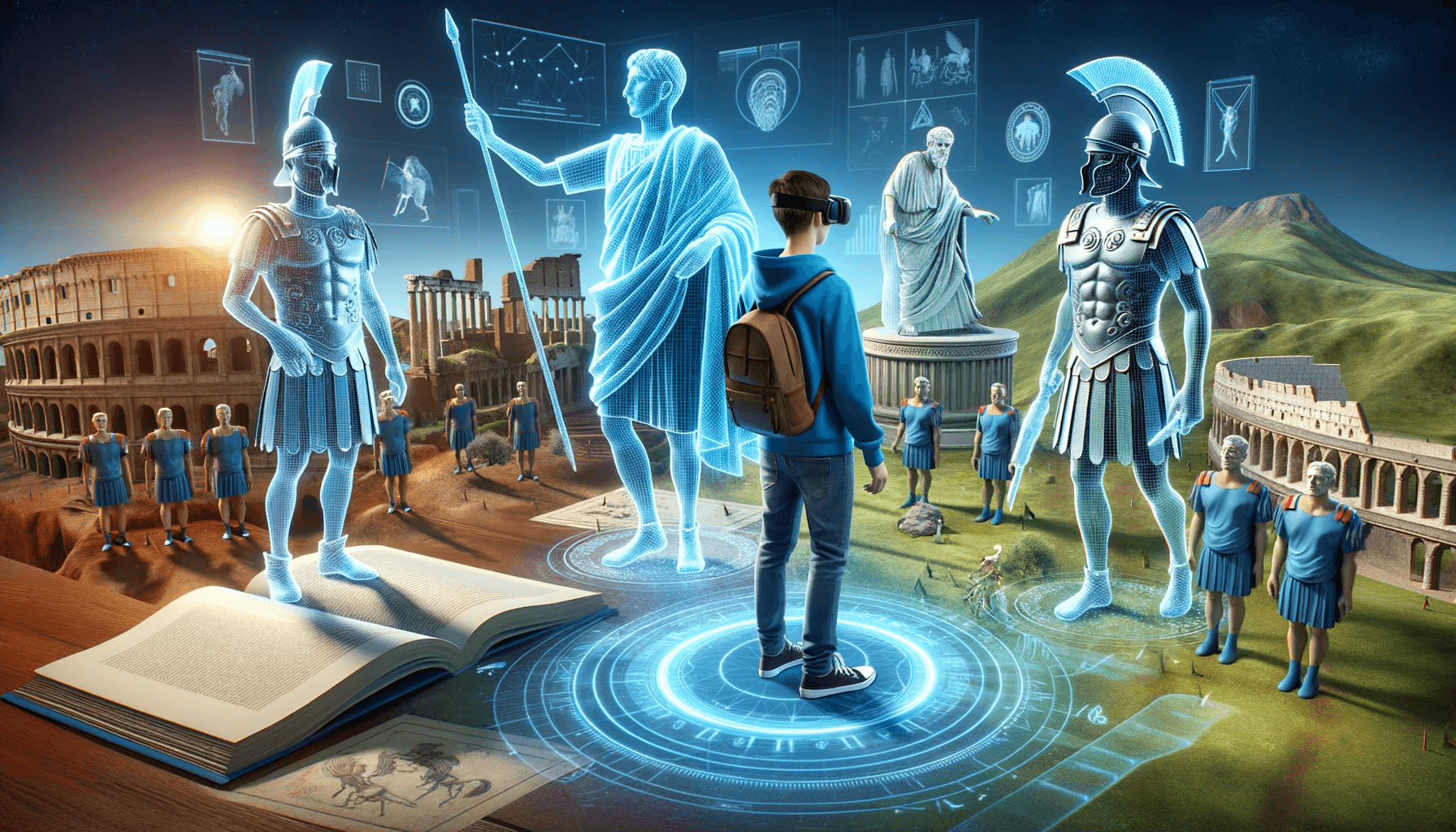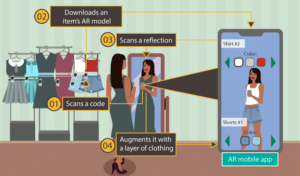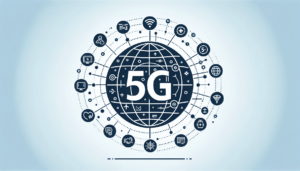Table of Contents
In today’s fast-paced world of technological advancements, Virtual Reality for Training and Education is emerging as a pivotal innovation. This technology transcends traditional boundaries, offering a multi-dimensional, interactive learning experience that engages the learner in ways previously unimaginable.
This extensive guide aims to serve as a cornerstone resource for understanding how Virtual Reality is revolutionizing training and educational paradigms. We’ll delve into its applications across various sectors, from corporate training modules to academic courses. We’ll also explore the benefits of enhanced retention and engagement, the challenges of technological integration, and the ethical considerations that come with the adoption of VR in educational settings.
Whether you’re an educator, a training professional, or someone interested in the future of learning, this guide will provide you with valuable insights into how Virtual Reality for Training and Education is setting new standards and opening up unprecedented opportunities.
So, are you ready to dive deep into the transformative impact of Virtual Reality on training and education? Let’s get started.
The Evolution of Virtual Reality in Learning: From Concept to Application
As Virtual Reality for Training and Education gains traction, it’s essential to understand how this technology has evolved from a novel concept into a practical tool for learning. This section will explore the historical context, current applications, and future potential of VR in educational settings.
Historical Context
Virtual Reality has come a long way since its inception. Initially seen as a tool for gaming and entertainment, it has now found applications in various fields, including education and training. Early adopters were primarily in specialized sectors like aviation and healthcare, where high-fidelity simulations could provide invaluable training experiences.
Current Applications
Today, the use of Virtual Reality in educational settings is more diverse:
- Corporate Training: Companies are using VR to simulate real-world scenarios for employee training, from customer service to emergency response.
- Academic Education: Schools and universities are incorporating VR to offer immersive lessons in subjects like history, science, and even art.
- Skill Development: Specialized training programs are using VR to teach complex skills, from surgical procedures to mechanical repairs.
Future Potential
The future for Virtual Reality in education looks promising:
- Global Classrooms: VR could make distance learning more interactive, bridging the gap between students and teachers worldwide.
- Adaptive Learning: With AI integration, VR could offer personalized learning experiences tailored to individual needs.
- Ethical and Social Implications: As VR becomes more prevalent, discussions around data privacy and ethical considerations will become increasingly important.
By understanding the evolution of Virtual Reality for Training and Education, we can better appreciate its current applications and future potential.
The Advantages and Challenges of Using Virtual Reality for Training and Education: A Comprehensive Analysis
When considering the implementation of Virtual Reality for Training and Education, it’s vital to have a well-rounded understanding of both its advantages and challenges. This nuanced perspective is invaluable for educators, training professionals, and organizational decision-makers.
Advantages
Immersive Experience
One of the standout benefits of using Virtual Reality is the immersive learning environment it creates. This immersion allows learners to engage with the content on a deeper level, making the learning process more effective.
- Real-world Simulations: VR can replicate real-world scenarios, providing practical experience without the associated risks.
- Interactive Learning: The technology enables hands-on interaction, which can be particularly beneficial for kinesthetic learners.
Enhanced Retention
The interactive nature of Virtual Reality for Training and Education has been shown to improve retention rates.
- Active Participation: VR encourages active rather than passive learning, which studies show leads to better retention.
- Immediate Feedback: Virtual Reality platforms often include immediate feedback mechanisms, allowing learners to correct mistakes in real-time.
Safe Training Ground
Virtual Reality offers a risk-free environment for practicing potentially dangerous or complicated tasks.
- Hazardous Situations: Industries like healthcare and aviation use VR to simulate emergency scenarios for training purposes.
- Cost-Effectiveness: While the initial setup may be costly, VR can save money in the long run by reducing the need for physical materials and locations.
Challenges
Cost of Implementation
The financial aspect is one of the significant challenges in adopting Virtual Reality for Training and Education.
- Hardware and Software: The cost of VR headsets and the software required can be a barrier for many organizations.
- Maintenance: Ongoing costs for software updates and hardware maintenance can add up over time.
Technological Limitations
While VR technology is continually evolving, it’s not without its limitations.
- Motion Sickness: Some users experience discomfort or motion sickness while using VR.
- Hardware Requirements: High-quality VR experiences often require powerful computing capabilities, which may not be accessible to everyone.
Accessibility
Ensuring equal access to VR-based education is another challenge.
- Equipment Availability: Not all students or trainees may have access to the necessary VR equipment.
- Digital Divide: The technology could exacerbate existing educational inequalities if not implemented thoughtfully.
By thoroughly understanding both the advantages and challenges of Virtual Reality for Training and Education, you’ll be better equipped to make informed decisions regarding its implementation.
Practical Applications: An In-Depth Look at How Virtual Reality for Training and Education is Transforming Industries
Understanding the real-world applications of Virtual Reality for Training and Education is crucial for grasping its transformative potential. This section will offer a comprehensive look at how various sectors are employing VR to revolutionize their training and educational programs.
Corporate Training
Customer Service Simulations
Companies are increasingly using Virtual Reality for Corporate Training to simulate customer service scenarios. These simulations offer a safe space for employees to practice handling customer complaints, queries, and other interactions, thereby improving their customer service skills.
- Realistic Scenarios: VR can mimic real-world customer interactions, complete with varying levels of difficulty and complexity.
- Performance Metrics: Many VR platforms offer analytics to assess employee performance, providing valuable feedback for improvement.
Emergency Response Drills
Virtual Reality is also being used to prepare employees for emergency situations, ranging from fire drills to cybersecurity attacks.
- High-Stakes Training: VR allows for the simulation of high-stakes scenarios without the associated risks.
- Team Collaboration: These simulations often require team-based responses, improving collaborative skills among employees.
Healthcare Education
Surgical Training
One of the most impactful applications of Virtual Reality for Training and Education in healthcare is surgical training. Medical students and professionals can practice complex surgical procedures in a controlled, risk-free environment.

- Anatomical Accuracy: High-fidelity VR simulations can replicate human anatomy with remarkable accuracy.
- Skill Assessment: Advanced VR platforms can assess the user’s performance, offering immediate feedback and areas for improvement.
Patient Care Simulations
Virtual Reality is also used to simulate patient experiences, thereby enhancing empathy and the quality of care among healthcare professionals.
- Empathy Training: VR can simulate the experiences of patients with various conditions, from physical disabilities to mental health issues.
- Decision-Making: These simulations can also help healthcare providers practice making quick, informed decisions in critical situations.
Academic Learning
Virtual Field Trips
Educational institutions are increasingly using Virtual Reality in Academic Learning to take students on virtual field trips. These trips allow students to explore historical landmarks, museums, and even outer space without leaving the classroom.
- Global Exposure: Virtual field trips can expose students to cultures and environments they might not otherwise experience.
- Interactive Learning: These virtual experiences often include interactive elements, enhancing engagement and retention.
Science Experiments
Virtual labs are another application, allowing students to conduct experiments that might be too dangerous, expensive, or logistically challenging in a real-world setting.
- Safety: Virtual labs offer a risk-free environment for experimentation.
- Resource Efficiency: These labs can also save on the costs of materials and equipment.
Skill Development
Technical Skills
Specialized training programs are employing Virtual Reality for Skill Development in fields ranging from automotive repair to computer programming.
- Hands-On Training: VR offers a practical, hands-on approach to learning complex technical skills.
- Customized Learning Paths: Advanced VR platforms can offer personalized training modules based on the learner’s progress and needs.
Soft Skills
Virtual Reality is also being used to train soft skills like communication, leadership, and teamwork.
- Social Simulations: VR can simulate various social scenarios, from networking events to job interviews, allowing for practice in a controlled environment.
- Feedback and Improvement: Many VR platforms offer real-time feedback, helping users identify areas for improvement.
By exploring these in-depth practical applications, we can fully appreciate the transformative impact of Virtual Reality for Training and Education across various sectors.
Ethical and Accessibility Considerations in Virtual Reality for Training and Education
As the adoption of Virtual Reality for Training and Education continues to grow, it’s crucial to address the ethical and accessibility considerations that come with it. While VR offers transformative potential, it also raises questions about equitable access, data privacy, and ethical use.
Equitable Access
One of the most pressing concerns is ensuring that VR technology is accessible to all learners, regardless of their socio-economic background.
- Cost Barriers: High-quality VR setups can be expensive, potentially excluding lower-income individuals or institutions.
- Geographical Limitations: Access to VR technology may also be limited in rural or less developed areas.
Data Privacy
The use of Virtual Reality for Training and Education often involves the collection of user data, raising concerns about how this data is stored, used, and protected.
- User Tracking: Many VR platforms track user movements and interactions for analytics, which could potentially be misused.
- Data Encryption: Ensuring that sensitive data is encrypted and securely stored is paramount.
Ethical Use
The immersive nature of VR also raises ethical questions, particularly when simulating real-world scenarios that could be sensitive or controversial.
- Content Sensitivity: Care must be taken to ensure that VR simulations do not perpetuate stereotypes or misinformation.
- Informed Consent: Users should be fully informed about what the VR experience entails, especially in training scenarios that may include stressful or challenging situations.
By addressing these ethical and accessibility considerations, we can work towards a more inclusive and responsible implementation of Virtual Reality for Training and Education.
Conclusion: The Transformative Impact of Virtual Reality for Training and Education
As we reach the end of this comprehensive guide, it’s clear that Virtual Reality for Training and Education is more than just a technological trend; it’s a transformative tool that has the potential to revolutionize how we learn and train. From corporate settings to academic classrooms, VR is breaking down traditional barriers and setting new standards for educational excellence. According to a trend analysis, the integration of VR into education promises a transformative impact on teaching and learning processes.
Key Takeaways
- Immersive Learning: Virtual Reality offers an unparalleled level of immersion, making learning more engaging and effective.
- Practical Applications: Various sectors, from healthcare to corporate training, are already harnessing the power of VR for educational purposes.
- Ethical and Accessibility Concerns: While VR offers immense potential, it’s crucial to address the ethical and accessibility issues that come with its widespread adoption.
The Road Ahead
The future of Virtual Reality for Training and Education looks promising but is not without its challenges. As technology continues to advance, so will the opportunities for more interactive and personalized learning experiences. However, it’s crucial that these advancements are made with a focus on ethical considerations and equitable access.









